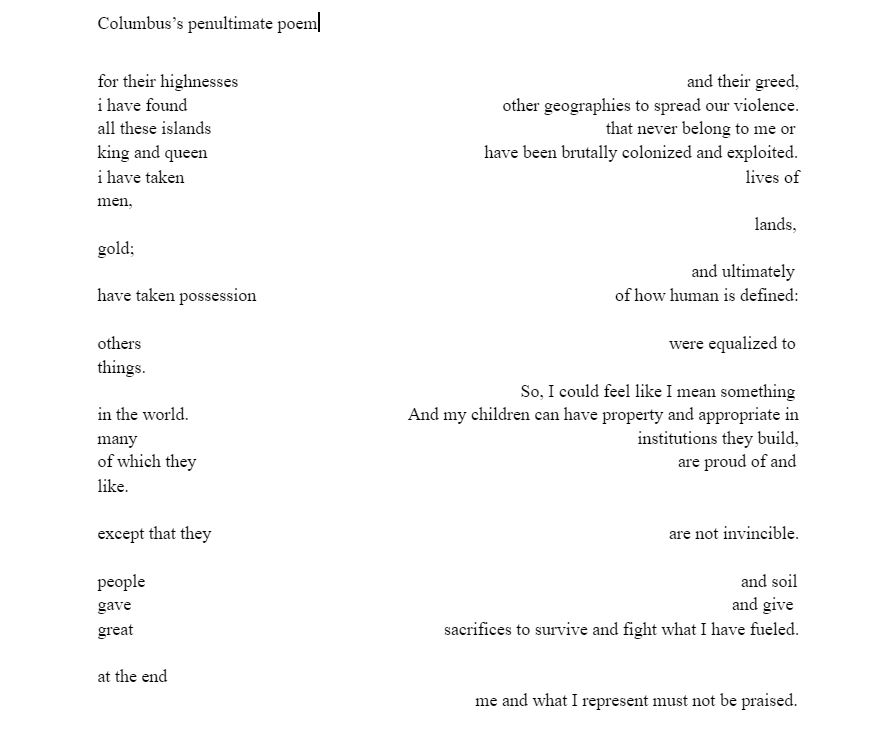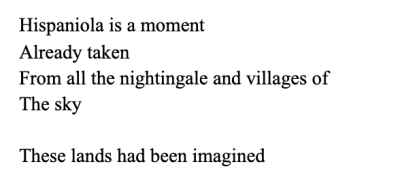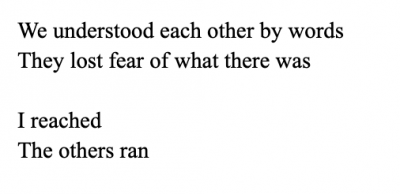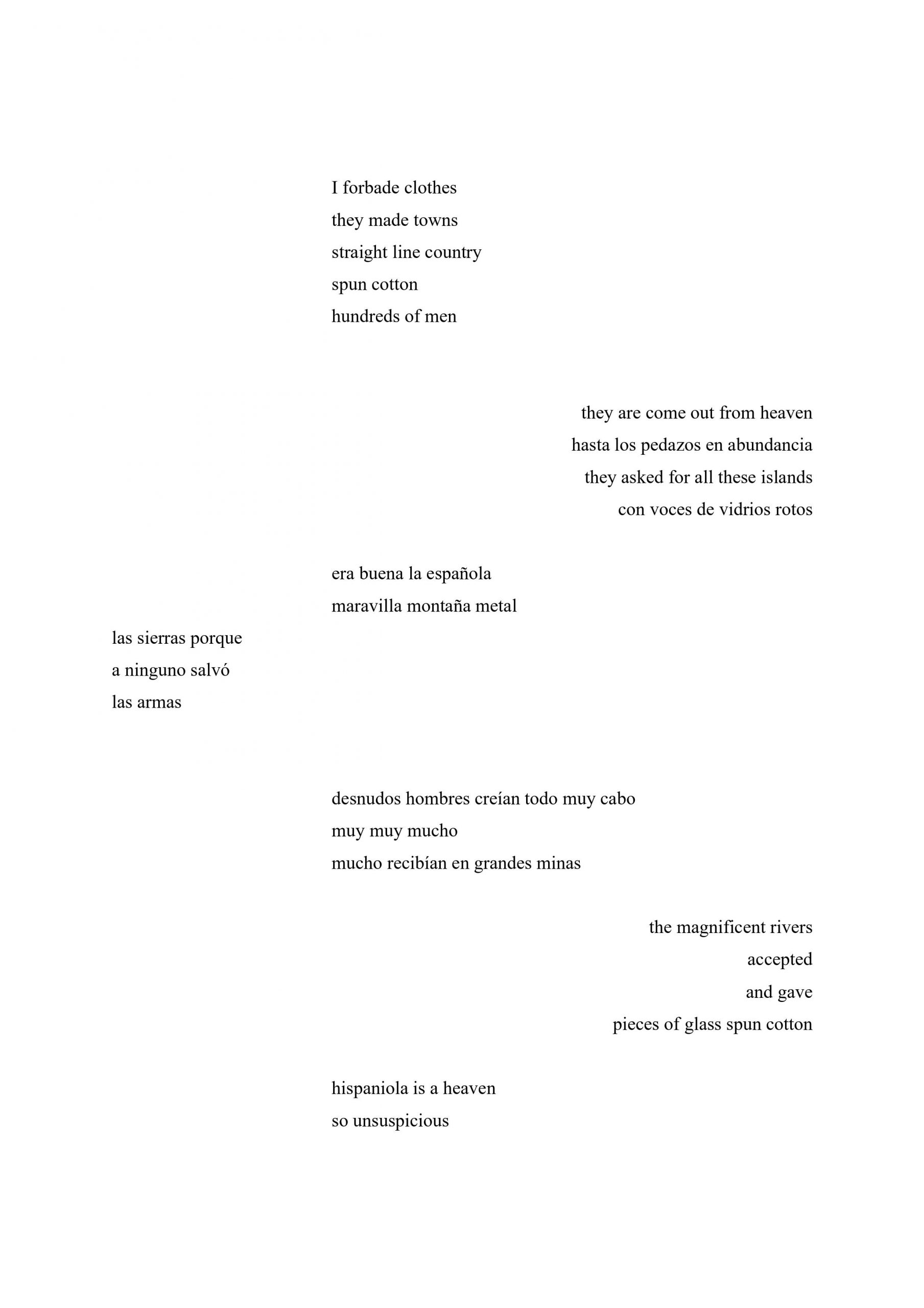“Experimental Topographies – Decolonial Methodologies begins with poetry as the condition of possibility for theory. The pursuit of poetics as a prelude to conceptualization and exegesis. This self-reflexive exercise acts as a collective prefacing attempt at broaching decolonial methodologies as an approach to Soil. A caveat: These are all experiments. Process is key here. Just like “Man” needs to justify his intervention over “Nature” at every turn, so do we tread into the abyss with the original state of the world itself: poetry.
A first exercise in decolonizing our writing practices came from the toolkit that comes with Sexual Violence: Violence on the Land, Violence on Our Bodies (2016), written in partnership with the Native Youth Sexual Health Network and Women’s Earth Alliance. We described an element in nature and without using gender or proprietary connotations. In English, it meant using proper nouns instead of common nouns – describing Land and not the land, to speak about Soil and not the soil – and, also, being aware of adjectives that could carry gendered subtext. Of course, the exercise required different levels of attention to the ways we address Nature in different languages, such as Spanish and Portuguese that have lexical gender or Kazakh that has one pronoun for he, she, it. Some key take-aways of this short writing exercise is the fact that we all have a relationship to creation, to natural elements; that “[o]ur relationships to creation are fluid, just like some peoples’ genders”; and that we do not need to gender Land, Sea, Mountain, or Soil, to have a relationship with them. On a grammatical level, our approach to Soil can also be decolonized, morpheme by morpheme.
Another crucial element we discovered was the primacy of metaphor in our written accounts of Soil. Regardless of what our approach was, this method undoubtedly falls into poetic language. This brought us to the notion that poetry, as a practice, can sometimes prelude the elaboration of theory. Could poetry decolonize? We wondered. How to measure such a notion? But again: the key is process, not result–the means to establish means for more means. The unfinished, the inconclusive, as a practice in non-linearity.
How can we utilize poetry as a tool towards breaking down cognitive colonial structures? The answer lay in the words themselves.
Soil, invariably, is not just a material entity: Soil is also discourse, metaphor, concept. Soil is also made up of words, and for centuries, certain ways of describing Soil were lost to history through genocide, calamity, displacement, diaspora, and the unsayable. New ways of relating to Soil were erected from those first ashes.
Columbus threw that first spark by way of his first letter, his very first, as an invitation to the Crown of Castille and Aragón to finance the pillaging, extraction, rape, and evangelization of the Indies.
This first letter is not just a symbolic entity: this letter was also a material reality. Soil birthed the trees turned into wood pulp and provided the raw materials for the ink whose technological invention allowed for these words to be recorded for posterity, for our wonder and horror. Words in that letter, recorded material reality, had both the symbolic and the material power to transform Soil in America into tabula rasa–an empty, virginal territory just begging to be conquered, a vast expanse upon whose flesh Man could see his reflection eternify. All the symbolic and poetic might found in Soil before the Conquest was slashed away, again and again, one treaty and nation-state after the other.
La Española es maravilla; las sierras y las montañas y las vegas y las campiñas, y las tierras tan hermosas y gruesas para plantar y sembrar, para criar ganados de todas suertes, para edificios de villas y lugares.
These words hide nothing in their intent. This first letter is the origin of the hegemony of words over Soil. This letter was the first pane of translucent pink glass the Catholic Kings saw through and into the great continental expanse.
Can poetry break down this pane of glass?
We came up with the idea of passing this letter through a text mixer/randomizer. Body to flesh, Land to soil, Glass to words. We shatter the pink glass and reduce this colonial window to its bare minimum: black scribbles over a blank plane.
To pass Columbus’s first letter through a text randomizer is to reduce its colonial authority, its millenary echoes, to basic units of glass. We can take these shards as material evidence of violence and reshape them through randomizing, through mixing, through process, through poetry.
These words that once turned Soil into flesh to be consumed are now offered through us as our reclaiming of Soil. This first collective gesture is an offering to Soil–the words of the colonizer re-worked on a material, symbolic, metaphysical level. Success is not our end–but poetry as a mean for more poetry as a mean for more poetry… and so on.
These glitched-out, irreverent, at times incoherent, lines provide a skewed, opaque wordscape as a prelude to our individual projects. As a common rooting, we meet in Soil through language to radicalize further, to grow out of step yet in tune, to rhizomize into our specific topographies and explore what it is to practice and/or process decoloniality.
Go to Victor Lozano’s Testing Perception – Reimagining Space & Movement.

For the collective exercise, I took all of the direct quotes I had written down from Columbus’s letter and organized them into one paragraph. I put this paragraph through a couple of different “randomizer” softwares, before I landed on one that really messed with the spaces between the words and phrases. At first, I had trouble not fixing the results, and I caught myself trying to correct the big gaps between words, and worrying about whole pages that were left blank. I also caught myself trying to correct seemingly “incorrect” words that had been spliced together. I asked myself why I was doing this, why I was trying to make the document cleaner, and why I was having a hard time controlling my automatic reactions to correct the results. I knew that I was coming into contact and disturbing my preconceived notions of what is and what ought to be. After realizing this, I started to embrace the distortion of the text and gave up trying for a specific result. When I was through with the software, I began to use the results it had generated as building blocks to create a visual topography. I began to incorporate ideas that I had been using in my own project and experimentations at Fort Tilden. I started to play with the color of the font and page to see how faint I could make words versus how I could highlight them. I began to think about what was visible versus invisible, what stuck out versus what was hiding. This is something I played with a lot at Fort Tilden. More specifically, how to blend into my surroundings so that I didn’t have to be the focus. By de-centering myself from focus, less prominent features and movements of the land emerged. This is how I approached Columbus’s words in my poem/topography—I chose to ignore and de-center the text from any meaning, and instead to use it as raw material for making relationships in space, color, and shape.
Go to Miro Spinelli’s Towards an abyssal praxis in 5 moves.
First I selected the paragraph from Columbus’ letter I thought spoke to what I am working on for this project, the one with monsters and flesh. Then I scattered it in a text mixer a few times, until I found some new interesting ideas in it. Looking at the new text as topography, flirting with the fragmented and seeking the mysterious, I created a few abysses in it by selecting some word combinations and blacking out others. As a first glimpse of what an abyssal praxis may look like, the exercise showed itself to be more about suggesting, inciting, creating texture and relief than of producing closed meanings.

Go to Lauren DeLeon’s Language of Land.
I approached this project with the idea of sifting. As I put text into the word mixer, I searched for moments of clarity that appeared — phrases that seemed to speak for the land. I was looking for words that reflected the beauty and truth of Hispaniola amidst the cruelty that Columbus’s letters initially show us. I took chunk after chunk of writing, looking for phrases that dug through the contaminated words to find something pure and clean. I was searching for language of care and simplicity. Few phrases came up with this method — so much of the words were ‘soiled’ by language of suffering. I choose to reflect that and be honest to what the words had given me. Most of the language speaks of destruction. I used this to begin searching for ways in which the words could become something else. Could I sift through the language even deeper to create something new with it? How would cutting up the words further and further show the truth of what they had done? Where does the land speak for itself? I used this method further in my own project to examine how the agency of land exists in our language and our physical spaces. I wanted to sift through the contamination and hear the lands words.
Go to Anel Rakhimzhanova’s Musicking back to land.

My approach to turning a text rooted in the history of violence into a poem is informed by academia as a practice. Within the labor of Western academia, that we are located in, where every body has a different degree of detachment from the land we are walking on, it is also an (often exhaustive) critical gesture where analyzing the canons of Western thought becomes a prerequisite to proposing and repairing the worldviews marginalized by them in the first place. With Columbus’s letter, the “canon” we are deconstructing, I’ve used a shorthand, I let the text processor identify the most used words and phrasings of the letter and rearranged them into a poem that still conveys the ideas of the original into the first column. I used the second column to complement words in the first column and convey a certain decolonial critique. Since this form of decolonial gesture still maintains a positionality from which it is hard to engage with or hear the topography changed through colonial presence, I’ve decided to listen closely to what soil, wind, water will tell me through New York’s soundscape. Musicking of land and back to it, a method of repairing topographies that I talk more about in my writing, led me to the streets and parks of the city where that attentiveness to the landscape and soundscape brought me to birdwatchers whose ears and eyes are always attuned to it. You will hear some birds and also 12 other sonic layers – each layer already rich with the noises of the city – that together can be associated with any place within NYC, further reinforcing the inseparability of texts, places, sounds.
Go to Gabriel Carle’s Reaching and Recasting Soil through Art and Performance.
My approach to Columbus’s letter was intercepted by my more recent poetic experiments in the translingual and Spanish-English interference. Therefore, I looked up Columbus’s first letter both in Spanish and English and decided to throw them into the mixer to see what happens. First in Spanish, then in English, I chose parts of the letter that most referenced natural elements and kept randomizing the text over and over. With enough shards of glass in my pocket, I started picking out suggestive wording and phrasing, in either language, and kept asking myself: whose voice is this, who is this I that now cuts my skin verse by verse? Upon constructing the poem, this I kept shifting from empire to nature, from ownership to collectivity, and Columbus’s words shifted to prelude the rape and pillaging of the Americas. The will of Man and Soil are inextricable, two imperial languages battle to translate the control of their own elements, words are displaced line Sand or Mud, and the poem reconfigures the original words to uncover their true intention: to conceal the intent to control Nature, whose voice is interrupted constantly by a Nature who resists objectification.
McKittrick, Katherine, and Sylvia Wynter. On Being Human as Praxis. Durham, NC: Duke University Press, 2015. Columbus, Christopher. 2014. "First Voyage of Columbus" Select Documents Illustrating The Four Voyages Of Columbus. Edited by Cecil Jane. 1-17. New York, NY: Routledge, 2016. Violence On The Land, Violence On Our Bodies. Berkeley, CA: WEA and NYSHN,






